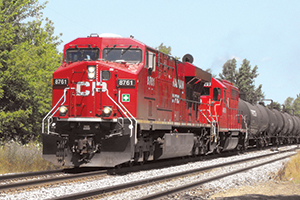Canadian Pacific Makes $28.1 Billion Offer for Norfolk Southern in Consolidation Move

Canadian Pacific Railway Ltd. last week presented Norfolk Southern Corp. with an acquisition offer worth at least $28.1 billion, rekindling the fires of rail consolidation that have been dormant since 1999.
The Canadian carrier said its cash and stock offer would lead to “a pro-competitive, pro-customer, coast-to-coast transportation solution” to lower costs, boost earnings and enhance service.
Norfolk Southern, which hadn’t responded to the offer by the time Transport Topics went to press, described the overture as “nonbinding, highly conditional” and “highly low premium,” suggesting a chilly reception.
The latest proposal would bring together Canada’s second-largest railroad, based in Calgary, Alberta, with the No. 2 carrier in the eastern United States, creating a company with annual revenue of about $16.6 billion, 37,000 miles of track, more than 40,000 workers and profit before interest and taxes of more than $5 billion.
Truck-rail, a key component of both carriers’ freight mix, totaled 4.75 million shipments and $3.82 billion in 2014 revenue.
“The company’s board of directors, in consultation with its financial and legal advisers, will carefully evaluate and consider this indication of interest in the context of Norfolk Southern’s strategic plans, and its ongoing review of opportunities to enhance stockholder value through strategic, financial and operational measures and pursue the best interests of the company and its stockholders,” the Norfolk, Virginia-based company said in a statement. “Notably, any consolidation among Class I railroads in North America would face significant regulatory hurdles.”
The last tie-up proposed, a combination of BNSF Railway and Canadian National Railway, was abandoned after opposition from regulators, shippers and rival railroads. That failed deal followed a decade of acquisitions involving all of the largest U.S. railroads, including Norfolk Southern.
In addition, the Surface Transportation Board, which would have to approve the new proposal, created rules in 2001 to make future acquisitions more difficult by forcing the applicants to prove that their combination would increase competition.
In an apparent nod to shippers and regulators, Canadian Pacific said it would open customer facilities that are currently served by one railroad to access from another carrier. That provision matches the desires of the National Industrial Transportation League shipper group, which first proposed that change to increase competition four years ago.
The agency hasn’t ruled on the so-called “open access,” a concept that U.S. railroads have opposed vigorously on grounds it would reduce profits and revenue.
Canada-based railroads, however, have prospered under national regulations that allow shippers to receive service from multiple carriers through switching arrangements.
Canadian National, which is based in Montreal, had the industry’s lowest third-quarter operating ratio at 53.8, with Canadian Pacific in second place among North American carriers at 59.8, nearly 10 percentage points better than the industry-worst 69.7 at Norfolk Southern.
Since CEO E. Hunter Harrison took over at Canadian Pacific in 2012, the carrier’s operating ratio has dropped 22.7 percentage points.
As a result, its profit before interest and taxes was about C$2 billion in the first three quarters of 2015. The comparable figure was $2.2 billion at Norfolk Southern, whose revenue is about 50% higher.
The Canadian carrier’s lines stretch across that nation, with extensions into the United States to reach Chicago, and a limited network in the Northeast, where Norfolk Southern operates. Its routes cover every state east of the Mississippi River.
“A combined entity will also lead to faster growth . . . versus what either of us would be able to achieve on our own,” Canadian Pacific’s letter said. It also cited potential improvements in service at bottlenecks such as Chicago.
Benefits cited in the letter included $1.8 billion in future “operating synergies” that could lead to a 45% increase in earnings on a per-share basis. Other identified advantages included global presence at ports on the Pacific, Atlantic and Gulf Coasts.
Canadian Pacific, which disputed the Norfolk Southern description of its proposal, is offering $46.72 in cash and a fixed exchange ratio of 0.348 Canadian Pacific shares per Norfolk Southern share — worth about $93 per share. Based on 302.5 million Norfolk Southern shares outstanding, the offer is worth $28.1 billion.
Norfolk Southern said that offer was a premium of less than 10% based on the Nov. 17 closing price, which was $86.97 per share.
Canadian Pacific, which called its offer a “sizable” premium, noted that the value of Norfolk Southern shares has appreciated in recent days after reports that a merger was in the works.
The Norfolk Southern move is the latest acquisition gambit by Harrison, who began his railroad career five decades ago.
Less than a year ago, he made overtures to CSX Corp., which rejected them. No formal offer was extended. He also was involved in the failed 1999 deal, when he was a top official at Canadian National. He retired from that company in 2009, 11 years after facilitating its acquisition of the Illinois Central Railroad.
Harrison, 71, returned to the industry in 2012 after investor William Ackman led a successful fight to oust previous Canadian Pacific management.

